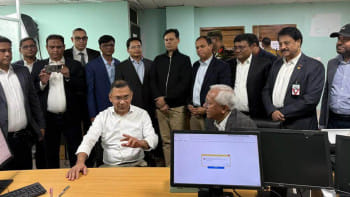How much has Bangladesh achieved from BRI?

The year 2026 marks a decade of Bangladesh's involvement in China's Belt and Road Initiative (BRI). On this occasion, it is important to assess what we have achieved from this partnership, its potential impact, and what can be done going forward. What began through Chinese President Xi Jinping's state visit to Bangladesh in 2016—with promises of transformative infrastructure, enhanced connectivity, and deepened trade links—has evolved into a complex chapter in our national development story. The BRI is China's global infrastructure development and connectivity strategy launched in 2013. It aims to boost trade, investment, and cultural exchange by building networks of roads, railways, ports, energy pipelines, and digital infrastructure across Asia, Africa, Europe, and beyond. For some, the BRI has been a gateway to long-overdue projects and regional integration, and for others, it has raised questions about debt sustainability, environmental impacts, and the balance of strategic interests.
After signing BRI, Bangladesh has seen the inaugural works of Padma Bridge, which is considered as one of the largest transport infrastructure projects in the country. We have also seen some development in other sectors, such as power generation, energy, railways, trade, etc, through enhanced investment partnership. Under the BRI, Bangladesh is expected to get $26 billion for projects and $14 billion for joint venture projects, totalling $40 billion. BRI initiatives have mostly been in the energy and transportation sectors in Bangladesh, where infrastructure investment requirements are projected to be equivalent to 1.5 percent of GDP in 2040.
The BRI projects have some geostrategic advantages as well. Chinese investment through the BRI is helping Bangladesh become a hub for regional connectivity. The country can become a fruitful land to connect the Bay of Bengal with the western provinces of China. Also, Bangladesh is now the only access point to the Bay of Bengal for China, as their relationship with India has declined in recent years and Myanmar is embroiled in a civil war situation.
However, some have raised concerns over debt and financial risk issues, as well as the governance challenges. When we saw how Sri Lanka leased Hambantota Port to a Chinese firm as it was not able to repay its loans to China, it raised the debt trap concerns. Experts, however, believe that Bangladesh is not entirely dependent on Chinese loans for infrastructure projects and has repaid loans within due time, which keeps us on the safe side. Another concern is our constantly poor performance in global corruption indexes, which leads to worries regarding effective investment fund management in the infrastructure development sector. Transparency International Bangladesh (TIB) reported in 2022 that more than Tk 390 crore was misappropriated across just three power projects due to inflated land costs and non-competitive bidding. Some projects advanced by less than 15 percent even after years. This depicts how poorly our governance mechanism has performed with foreign investment, and this is a risk for long-term projects like the BRI.
The environmental aspects of BRI received less attention compared to other issues. As we saw, several coal-fired power projects that were planned for BRI financing got cancelled, which created havoc in the investment climate. Later, China also committed not to invest in new coal-fired projects. In 2021, it institutionalised its decision to halt investment in coal projects abroad through Xi's own announcement at the UNGA. Now, Chinese investors are willing to invest in Bangladesh's renewable energy sector, but they are concerned about the country's poor investment climate, especially now. Another highly discussed environmentally malfunctioned BRI project has been the Karnaphuli Tunnel. The world is abandoning tunnel structures, as these are not suitable for the natural flow of rivers. Also, for an active delta like us, navigability is a huge concern, which got damaged by this tunnel.
As we near the completion of a decade of BRI involvement, it is fairly evident that we haven't been able to get the best out of it. Some assessment for improvement is required. As we are now seeing the development of different economic zones in Bangladesh, they can be a good ground for BRI investments. Connecting these economic zones with seaports and export hubs can positively accelerate our growth. BRI also offers an opportunity for us to become a regional hub for trade and commerce. Bangladesh is looking for aviation development, especially generating opportunities for domestic operations to enhance commercial activities and increasing capacities for international operations. BRI investment can also be engaged in this sector. As Bangladesh aims to produce 30 percent of its total power production through renewable energy by 2041, it requires more investment and infrastructural adjustments. BRI has opened the door for Chinese investors to provide the assistance to fulfil these targets. As China intends to make a significant geostrategic impact in South Asia, we can also channel this intention to seek Chinese investment through BRI to assist transboundary river management, especially issues related to the Teesta River.
There are a few spaces where we need to improve to make a sustainable impact on BRI execution in Bangladesh. First, geopolitical balance is a factor that needs consideration to make sure that Bangladesh's global image is one of neutrality. If our geopolitical language is more inclined to China, it might create misconceptions about our standing globally. Second, our policy should be of cooperation and impartiality. Third, we need to make sure political institutions remain unbiased and focused only on national interests during BRI engagements. Recently, some investors raised concern regarding investment protection and execution for renewable energy in Bangladesh. This issue needs to be addressed to ensure an easy transition. Fourth, environmental impact assessment reports of BRI projects should be made public and reassessed by different stakeholders to avoid unwanted circumstances. Our focus should be more on technology transfer and knowledge-sharing than on dependency on Chinese expertise.
Finally, public-private partnership projects can be a great base for knowledge-sharing and technology transfer. PPP projects involve a vast array of stakeholders from different sectors, which creates an opportunity to strengthen stakeholder capacity regarding infrastructure development, fund management, and innovation in project execution. It requires strong policy design and some adjustments in bilateral agreements in the future.
Dr Muhammad Badrul Hasan is associate professor in the Department of Political Science at the University of Dhaka.
Views expressed in this article are the authors' own.
Follow The Daily Star Opinion on Facebook for the latest opinions, commentaries and analyses by experts and professionals. To contribute your article or letter to The Daily Star Opinion, see our guidelines for submission.

 For all latest news, follow The Daily Star's Google News channel.
For all latest news, follow The Daily Star's Google News channel. 









Comments